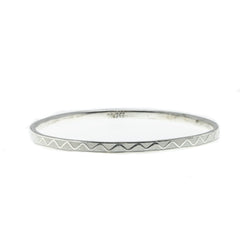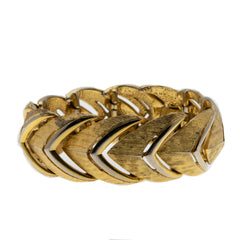Rosebud Adornment - Vintage Signed 'Lisner' Gold Plated Open-Work Bracelet (VBR205)
Rarities Antique Jewelry
Rosebud Adornment - Vintage Signed 'Lisner' Gold Plated Open-Work Bracelet. This attractive bracelet is crafted from gold plate over metal. Featuring a Lisner signature, vintage styling, and quality craftsmanship. This gorgeous bracelet is made up of moveable links which are designed with rosebuds and foliage. The clasp is a fold over type, which opens and closes perfectly. The bracelet showcases beautiful open-work, and is in pristine condition. This vintage statement bracelet looks stunning when worn. Truly a great vintage piece to be enjoyed for years to come.
History:The first known gold plating occurred in northern Peru, where Pre-Columbian smiths gilded and silvered copper pieces by electrochemical replacement techniques. During excavations in the late 1980s, archaeologists discovered gold and silver ornamental and ceremonial artifacts dating all the way back to AD 50-300. However, it wasn't until 1805 that Italian chemist Luigi Brugnatelli invented electroplating.
Most importantly, popularly, and universally, the rose symbolizes romance and love. But rosebuds are also a symbol of beauty and courage. Of course, there are other meanings implied depending on context and the culture: desire, admiration, and passion, for instance.
Although the D. Lisner Company may have been officially founded in 1904, its roots go back to post-Civil War New York City where David Lisner, his father Selig, and brothers, George and Abraham, were merchants selling "fancy goods" in 1869. The family emigrated from the central German region of Saxe-Meiningen in 1864. In fact, Selig's occupation is listed as that of "merchant" on his Ellis Island Immigration manifest. Brother George died in 1894 and Abraham left the family business to found his own successful department store, Palais Royal in Washington, D.C.
Lisner's business was largely wholesale and was comprised of goods imported from Europe, including jewelry, hat pins, crystal giftware and clocks. David Lisner's son, Sidney, and a cousin Saul (Solomon) Ganz, eventually joined the business in the early part of the 20th century. In a 1915 New York City directory, David and Sidney Lisner are listed as proprietors of "D. Lisner & Co." There is also another listing for a "D & Co.," which sold novelties with David and Sidney Lisner and Saul H. Ganz as owners. David Lisner died on May 6, 1923 at the age of 77.
As trouble brewed in 1930's Europe, importing jewelry and rhinestones proved difficult. At this time, Urie Mandle (father of Robert Mandle of the R. Mandle Co.) joined Lisner as a full partner to build a retail, domestically produced jewelry line in Providence, Rhode Island. Lisner did not own their own factory until the very end of their existence, but depended on Providence's vast resources of jewelry manufacturing facilities to get the job done. The jewelry, although manufactured by others, would then bear the Lisner name. Famed metal mesh purse manufacturer, Whiting & Davis even manufactured bracelets for Lisner. Iraida Garey, former vice president of product development for Lisner, said that when she and owner Victor Ganz decided they wanted a nautical look for the upcoming season, they would contract for the new line with a factory in Providence that specialized in nautical jewelry. The Lisner mark was first used in 1938.
Unlike some of Lisner's competitors, the jewelry the company produced in the 1950's and 1960's looks ageless and modern, with clean, sharp edges. Good design is timeless; Lisner jewelry has an abstract, geometric sensibility with designs that are often derived from nature, incorporating leaves, fruits and flowers. It captures the spirit of the age differently than the styles of Coro and Trifari jewelry from the same period did. The jewelry of the mid-century can often be fussy and overdone. Kate Ganz Belin remembers her father Victor's keen sense of fashion and good taste.
"He tried to get away from the Mamie Eisenhower thing", she said. Many notable Lisner designs feature translucent plastic "jelly" leaves which may have been manufactured by a company from Kaufbeuren or Neu Gablonz, Germany called Walter Fischer. This company was well-known for producing plastic leaves and it is known that Ganz made trips to Kaufbeuren for product development. Lisner jewelry retailed at an average of $1-5 per piece, an inexpensive but attractive and well-made fashion jewelry purchase. Lisner costume jewelry was sold all over the United States, but maintained a small sales force of about ten reps throughout the country.
As president of Lisner, Victor Ganz was a creative spirit and became involved in every aspect of jewelry production. He traveled weekly between New York and Providence to oversee manufacturing. After his in-house designer, Sidney Welicky retired, Ganz himself and Iraida Garey, vice president of product development, took over the designing responsibilities. Ganz' style could be seen in everything from the actual jewelry to the retail packaging and advertising. One of his unique packaging designs involved a long tube that made the jewelry look like it was hanging in mid-air; the line was called "Suspense".
The value of Lisner jewelry has surged in the last two years. In October 2006, a record price was achieved on eBay for the Lisner red maple leaf parure, comprised of a necklace, bracelet and earrings. The winning bid was $610! Part of the enjoyment of collecting jewelry is that there are many colors and styles within an individual line to collect. Just when you think you know of all the variations, a new one surfaces. There are at least fifteen colors and color variations of the maple leaf set alone. The resin leaves themselves have more than a dozen different shapes! Some of the colors are very rare and hard to find, but it makes the hunt all the more enjoyable. Beware! Fakes have recently entered the marketplace, primarily in the form of poorly constructed pins. Sometimes you will see multiples of these for sale on eBay, a good indication that the items are not legitimate. So far, no one has reproduced the "jelly" plastic Lisner jewelry.
Today, collectors appreciate Lisner fashion jewelry for its modern, art-inspired beauty. Victor Ganz may be well-known for his art collection, but he should also be remembered for the artistic, classic jewelry he created.
Measurements: Bracelet 7"
Weight: 34.20 grams
Condition: Excellent
Origin: America
Date: Circa 1960
.



















